Between 1634 and 2009, Finland was administered as several provinces. Finland had always been a unitary state: the provincial authorities were part of the central government's executive branch and apart from Åland, the provinces had little autonomy. There were never any elected provincial parliaments in continental Finland. The system was initially created in 1634. Its makeup was changed drastically on 1 September 1997, when the number of the provinces was reduced from twelve to six. This effectively made them purely administrative units, as linguistic and cultural boundaries no longer followed the borders of the provinces. The provinces were eventually abolished at the end of 2009. Consequently, different ministries may subdivide their areal organization differently. Besides the former provinces, the municipalities of Finland form the fundamental subdivisions of the country. In current use are the regions of Finland, a smaller subdivision where some pre-1997 läänis are split into multiple regions. Åland retains its special autonomous status and its own regional parliament.

Tavastia is a historical province in the south of Finland. It borders Finland Proper, Satakunta, Ostrobothnia, Savonia and Uusimaa.
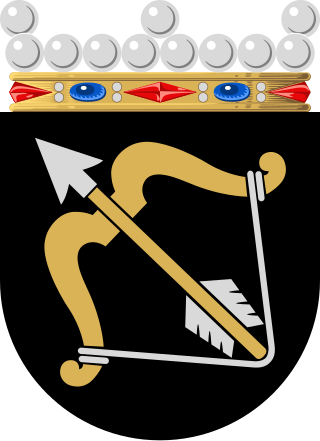
Savonia is a historical province in the east of Finland. It borders Tavastia, Ostrobothnia and Karelia. Savonia is now divided into two provinces: North Savonia and South Savonia. The largest cities in Savonia by population are Kuopio, Mikkeli, Savonlinna, Varkaus and Iisalmi.
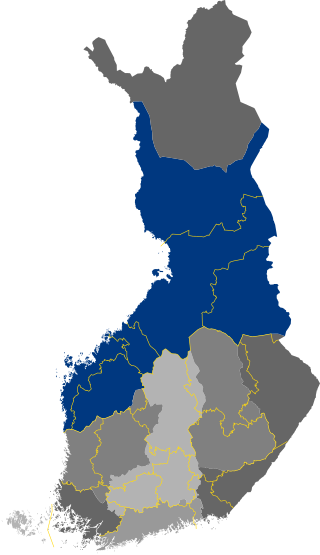
Ostrobothnia, Swedish: Österbotten, Finnish: Pohjanmaa is a historical province comprising a large western and northern part of modern Finland. It is bounded by Karelia, Savonia, Tavastia and Satakunta in the south, the Bothnian Sea, Bothnian Bay and Swedish Westrobothnia in the west, Laponia in the north and Russia in the east.

The historical provinces of Finland are a legacy of the country's joint history with Sweden. The provinces ceased to be administrative entities in 1634 when they were superseded by the counties, a reform which remained in force in Finland until 1997. The provinces remain as a tradition, but have no administrative function today. The spread of Finnish language dialects approximately follows their borders.

Eastern Finland was a province of Finland from 1997 to 2009. It bordered the provinces of Oulu, Western Finland and Southern Finland. It also bordered Russia to the east.
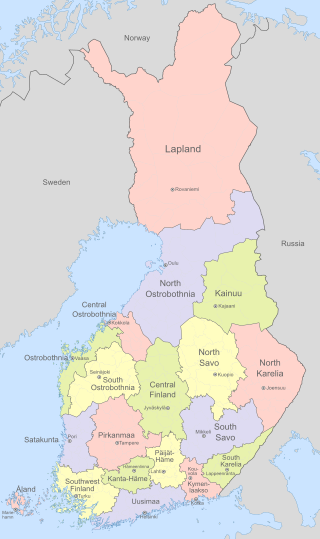
Finland is divided into 19 regions which are governed by regional councils that serve as forums of cooperation for the municipalities of each region. The councils are composed of delegates from the municipal councils. The main tasks of regional councils are regional planning, the development of enterprises, and education. Between 2004 and 2012, the regional council of Kainuu was elected via popular elections as part of an experimental regional administration.
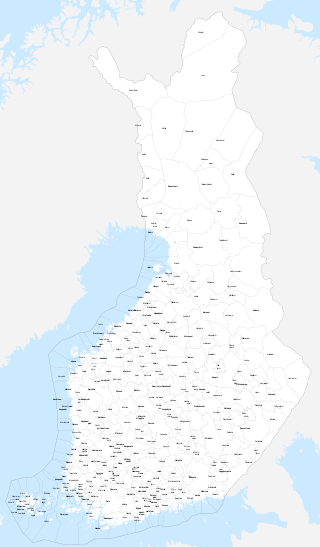
The municipalities represent the local level of administration in Finland and act as the fundamental, self-governing administrative units of the country. The entire country is incorporated into municipalities and legally, all municipalities are equal, although certain municipalities are called cities or towns. Municipalities have the right to levy a flat percentual income tax, which is between 16 and 22 percent, and they provide two thirds of public services. Municipalities control many community services, such as schools, health care and the water supply, and local streets. They do not maintain highways, set laws or keep police forces, which are responsibilities of the central government.

Joensuu is a city in Finland and the regional capital of North Karelia, located in the eastern interior of the country. The population of Joensuu is approximately 78,000, while the sub-region has a population of approximately 127,000. It is the 12th most populous city in Finland, and the ninth most populous urban area in the country.

Karelia is a historical province of Finland, consisting of the modern-day Finnish regions of South Karelia and North Karelia plus the historical regions of Ladoga Karelia and the Karelian isthmus, which are now in Russia. Historical Karelia also extends to the regions of Kymenlaakso, Northern Savonia and Southern Savonia (Mäntyharju).
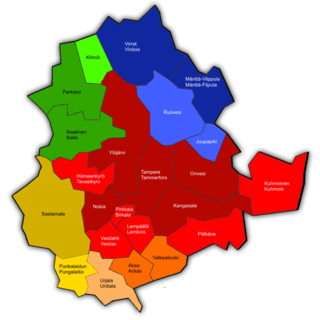
Pirkanmaa, also known as Tampere Region in government documents, is a region of Finland. It borders the regions of Satakunta, South Ostrobothnia, Central Finland, Päijät-Häme, Kanta-Häme and Southwest Finland. Most of the water area in the Kokemäki River watershed is located in the Pirkanmaa region, although Lake Vanajavesi is partly in the Kanta-Häme region. The region got its name from Pirkkala, which in the Middle Ages comprised most of present-day Pirkanmaa. Tampere is the regional center and capital of Pirkanmaa, and at the same time the largest city in the region.
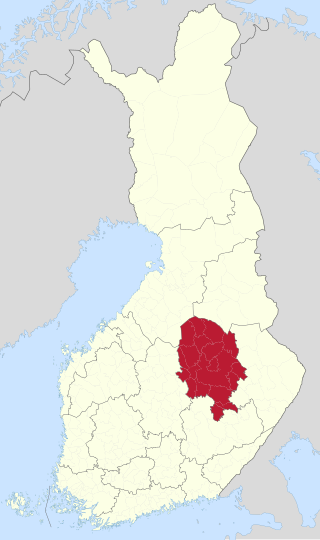
North Savo is a region in eastern Finland. It borders the regions of South Savo, Central Finland, North Ostrobothnia, Kainuu, and North Karelia. Kuopio is the largest city in the region and Lake Kallavesi is the largest lake in the region.

Karelia is an area in Northern Europe of historical significance for Russia, Finland, and Sweden. It is currently divided between northwestern Russia and Finland.
There are 13 electoral districts for elections to the Finnish Parliament. Each electoral district elects a number of MPs proportional to its population, currently ranging from 6 to 35 MPs, except Åland which only elects one.
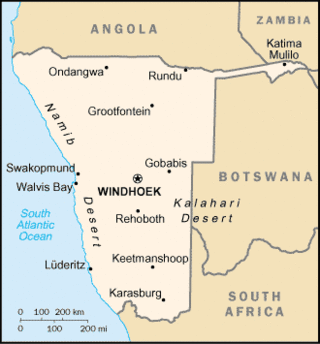
A salient is an elongated protrusion of a geopolitical entity, such as a subnational entity or a sovereign state.
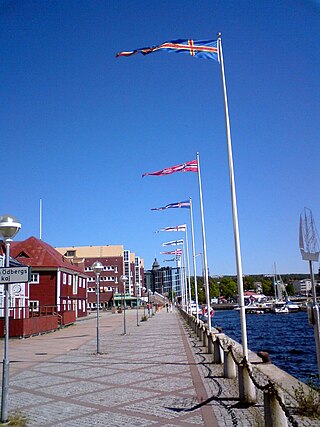
Household pennant is a quite common Nordic and Scandinavian tradition. A household pennant can be flown whenever there is no flag flying day and it is usually a means of telling that the "master of the house" is at home or simply for decorations. Due to this, pennants flags are usually a more common sight than the national flag in these countries. These pennants have a long, narrow, triangular shape, usually half the length of the flag pole. The pennants are also used in some countries for determining the wind direction. Unlike the national flag, which usually has a specific timeframe it can formally be flown during the day, pennants are regarded as more informal, and can be flown all day and night until worn out.
7th Division was a Finnish Army division in the Continuation War. The division was formed Savo-Karjala military province from the men in Pohjois-Savo and Pohjois-Karjala civil guard districts.
The wellbeing services counties are responsible for organising health, social and emergency services in Finland. There are 21 wellbeing services counties and the county division is mainly based on the region division. The public authorities are separate from the municipalities and from the central government.
Karelians, also known as Finnish Karelians or Karelian Finns, are a subgroup (heimo) of the Finnish people, traditionally living in Finnish Karelia. Karelians speak eastern dialects of the Finnish language: the South Karelian dialects are spoken in South Karelia, while the eastern Savonian dialects are spoken in North Karelia. The South Karelian dialects were spoken in the Karelian Isthmus prior to the Winter War. Karelians are traditionally Lutheran Christians, with an Orthodox Christian minority, belonging to either the Evangelical Lutheran Church of Finland or the Orthodox Church of Finland respectively.















